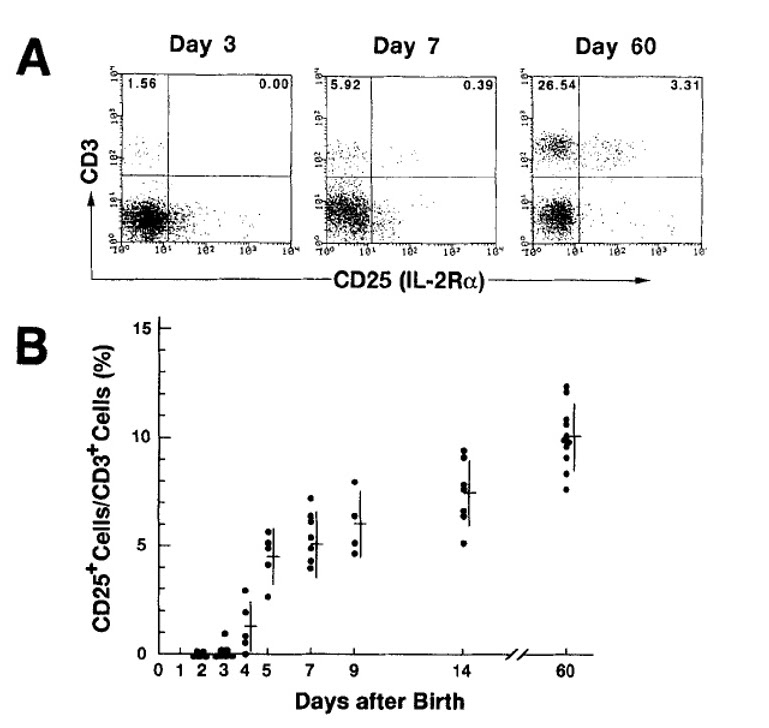reflections on my research history
Recently I was reflecting on my research journey over the past two decades, its challenges and achievements. Today, I want to highlight a crucial factor that guided my research direction and sparked my initial motivation to develop Tocky.
Encountering with the Problem
Launching my PhD at Sakaguchi lab in 2002, I focused on GITR as a potentially useful Treg marker (note this was pre-Foxp3 era). I aimed to replicate early Treg experiments, including the milestone paper Asano et al., J Exp Med 1996 from Shimon Sakaguchi’s group.
Asanot et al. claimed that CD25+ T cells do not appear before day 3 post-birth, which assertion was pivotal as it ‘proved’ that ‘depletion of Tregs’ by day 3 thymectomy caused autoimmunity.
I obtained a disturbing finding in 2003 (my second year in PhD): substantial numbers of Tregs existed in the neonatal spleen and thymus as early as day 1 after birth. This finding starkly contradicted the key claim of the Treg milestone paper by Asano et al., 1996.

Confirming the Non-Reproducibility
This finding was not isolated – Dujardin et al., PNAS, 2004 from the Bandeira group presented very similar data to what I had discovered.

Status Quo
At that time, I believed that the Treg theory, which relied heavily on the findings of Asano et al 1996, would soon be revised. Unfortunately, that has not happened.
Many textbooks and reviews have echoed the findings of Asano et al, despite the evidence to the contrary regarding neonatal Treg dynamics. More recently, a milestone article on Treg by Svoboda, Nature, 2022 still references the outdated notion as below.

Redefining Treg Research: Beyond the Boundaries
This experience led me to scrutinize widely accepted papers and theories in the Treg field critically, convincing me that the Treg theories and concepts themselves needed substantial revision.
This realization prompted my move from Japan to the UK in 2009 to extend my research and develop new tools to investigate Treg. This endevour resulted in the development of the multidimensional method Canonical Correspondence Analysis (CCA) in genomics (Ono et al., 2013) and Tocky (Bending et al., 2018).
Later Development
The implications in the issues within Asano et al were profound. I later examined the effects of these and wrote a theoretical/opinion paper, analysing evidence from past papers and proposing a new perspective (Ono & Tanaka, 2016).
Further, given that the belief that Tregs constitute a unique lineage of cells originates from, and is supported by, the findings of Asano et al., it is urgently required to establish a new research framework to investigate Foxp3 and Treg, without relying on the idea of a stable lineage.
Our second Tocky publication published in the EMBO Journal (Bending et al., 2018) investigated temporal dynamics of Foxp3 transcription and thereby addressed this challenge.
References
2018
- A timer for analyzing temporally dynamic changes in transcription during differentiation in vivoJournal of Cell Biology, 2018The foundational publication introducing Tocky technology by the Ono lab, marking a breakthrough in T cell and B cell studies.
- A temporally dynamic Foxp3 autoregulatory transcriptional circuit controls the effector Treg programmeThe EMBO journal, 2018The second Tocky paper from the Ono lab uncovers the temporally dynamic regulation of Foxp3 transcription, offering new insights into T cell regulation.
2016
- Controversies concerning thymus‐derived regulatory T cells: fundamental issues and a new perspectiveImmunology and cell biology, 2016A landmark opinion piece challenging the reproducibility of a foundational Treg experiment, while introducing a groundbreaking dynamic view on Foxp3-mediated T cell regulation.
2013
- Visualising the cross-level relationships between pathological and physiological processes and gene expression: analyses of haematological diseasesPLoS One, 2013The pioneering study developing Canonical Correspondence Analysis (CCA) as a genomics method, establishing a novel approach for transcriptome analysis.
Enjoy Reading This Article?
Here are some more articles you might like to read next: